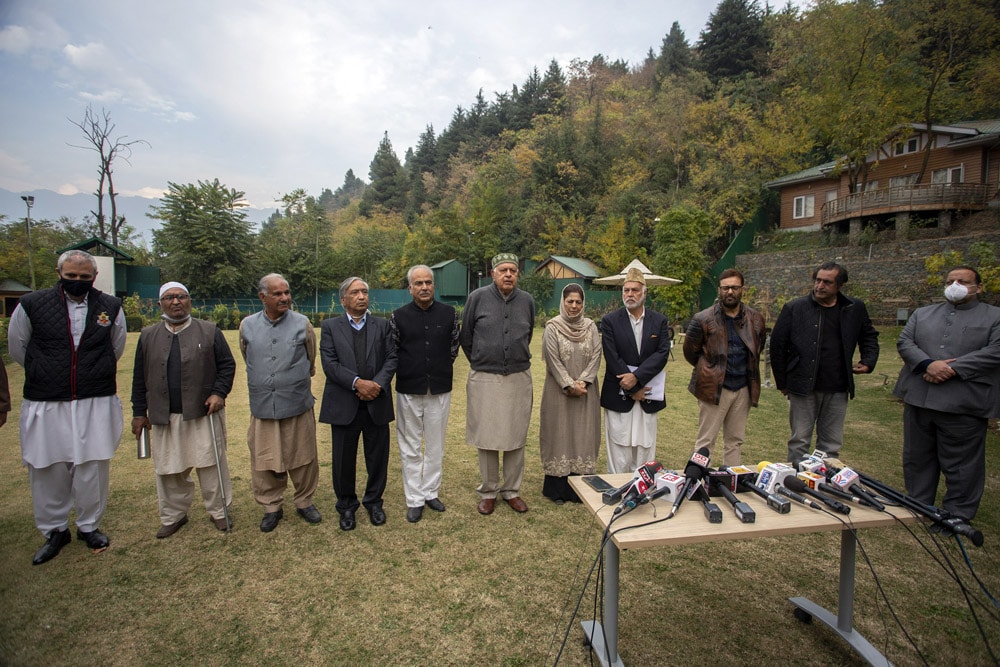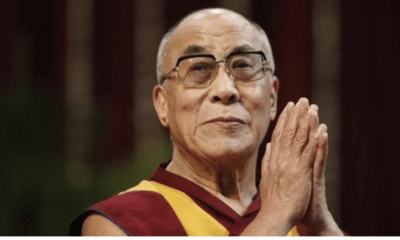
|
Getting your Trinity Audio player ready...
|
After DDC election results, it’s time to curb radicalism and start winning Kashmiri hearts and minds again
Several weeks after the completion of the District Development Council (DDC) elections and declaration of results, the Gupkaris are struggling to form the councils. In an exuberant mood, the Gupkar leaders declared the results to be a victory for their anti-Delhi agenda. Yet, the internal power struggle in the Gupkar Alliance is so intense that they are unable to elect a chairman and a vice-chairman in each district.
The People’s Alliance for Gupkar Declaration (PAGD) has never been a coherent bloc. Serious differences surfaced among the constituent parties during the seat-sharing exercise itself leading on one occasion to Mehbooba Mufti of the Peoples Democratic Party (PDP) boycotting the meeting. Farooq Abdullah had to personally intervene and bring her back to negotiations. An uneasy and reluctant truce prevailed in the final seat sharing leading to several aspirants from each party joining the election fray as independents against the official PAGD nominees. Despite tall claims, the alliance could finally secure only 80-plus seats in the Valley out of 140. More than 30 seats were won by the independents. Mutual mistrust and suspicion have resulted in a consensus on leadership of the councils eluding the PAGD. Meanwhile, party-hopping of the elected PAGD members has also started in some districts leading to complaints of horse-trading.
People showed their enthusiasm by way of turning out in large numbers to vote and elect their DDC members in the recent DDC elections. Traditionally, boycott calls by the separatists and terrorists used to mar electioneering in Kashmir and lead to dismal turnout. But not this time. Disobeying threats and intimidations, people turned up in large numbers. Srinagar, which used to record a low turnout most of the times, witnessed over 32 per cent polling. Except for the traditional terrorist hotbeds, like Pulwama and Shopian, all other districts in Kashmir recorded voter turnout ranging from 25 per cent to 55 per cent.
This should cheer up everyone who cares for democratic institutions to blossom in the strife-torn region. It is important to encourage the process of cultivating a new and grassroots leadership in the Union Territory, on which all political parties should come together. Such a consensus should also pave the way for holding elections to the Union Territory’s legislature and handing over power to the elected representatives in the near future.
However, the larger challenge of separatism is not yet fully over in Kashmir. In an election that was open, fair and transparent, with all the political parties in the fray, there remained a large cross-section of over 66 per cent people who did not participate. Some of them could have stayed away out of terrorist scare. But a bigger section seems to have deliberately refused to participate. Over the decades, the political parties have cultivated vote banks in the region. Sections of voters have developed traditional loyalties to either of the Valley parties or the national parties. It is those families that have come out and participated in the elections in large numbers this time, increasing the average voting percentage to around 34 per cent.
While the traditional voters turned up for voting, the younger voters stayed away. It is time that our attention is turned to this non-voting population. It is here that the future challenge to the Indian state lies. While we celebrate the decimation of separatist bodies like the Hurriyat and marginalisation of the Valley-based parties, we should not miss the point that they have not been replaced by any pro-India parties or organisations. National parties continue to occupy a humble space only in Valley politics while the new entrant, the Apni Party led by Altaf Bukhari, didn’t succeed in making major inroads. This scenario calls for careful calibration.
There is growing radicalisation among the young population over the past few years. This wave of radicalisation is different from the past. Radicalism witnessed in the past was largely about autonomy and special status of J&K, championed by groups like the JKLF, Hurriyat and others. The Indian state has succeeded in curbing the activities of these forces. But that space is now being taken over by radical Islamist forces. It is Islamic radicalism that is weaning away the Valley youth towards a dangerous course.
People of no other Indian state are so much influenced by a foreign country as those in J&K. Pakistan has been a dominant presence in the Valley politics for decades. The Kashmiriyat-centred radicalisation was largely a handiwork of Pakistan in the past. But now the young population of Kashmir is getting truly internationalised. You will find a Turkey, a Saudi, a Malaysia and an Iran in Kashmir today besides, of course, the continued presence of Pakistan. Of late, even China has entered the popular chatter on the streets of Srinagar.
Turkey’s profile is rising fast in the Valley. Posters and photos of Recep Tayyip Erdog˘an, President of Turkey, are a wide presence in Kashmir today. When Pakistan aired the dubbed version of the Turkish television serial Dirilis Ertugrul (Ertugrul’s Resurrection) last year, it became one of the widely watched shows in Kashmir too. The plot of the series, aired on a government channel in Pakistan with the open support of Prime Minister Imran Khan, is based on the life of a 13th century Turkish leader Ertugrul. Ertugrul’s son Osman Ghazi was the founder of the Ottoman Empire in Turkey. The series was about the Islamic armies fighting the Mongols, Christians, Byzantines and others under Ertugrul’s leadership. It glorifies Islam and projects it as a valiant and victorious faith over all other faiths. However, it was a violent depiction with acts like beheading and brutal wars.
Urdu and Arab Jihadi literature of the radical Islamic clerics like Syed Qutub and Syed Abu Ala Maudoodi’s interpretation of Islam or the Salafi preachings of Ibn Tayimmia to recent ones like Yusuf al Qaradavi are freely available in the Valley’s villages through the Jamaat-e-Islami-controlled mosques and maulvis. The Maulanas use Arabic nowadays in place of Urdu to hoodwink security forces and indulge in radical preaching. ‘Allahu makhraj junoodal Hind fil Kashmir’—is one such Arab prayer to Allah in many mosques today, which means, ‘Oh Allah! Take Indian Army out of Kashmir’. It provokes a loud ‘Amen’—approval from the attendees. Salafist preachers like Maulana Mushtaq Veeri, who openly support the ISIS, have considerable following in South Kashmir. Audio and video clips of Pakistan-based Barelvi jihadist preachers like Allama Khadim Hussain Rizvi or Mufti Qasim Fakhri make rounds in the Valley.
The influence of Iran in Kashmir was limited to senior Shia clerics in the past. But now, even among the ordinary Shias, the influence of Iranian politics is a growing factor. When Major General Qasem Soleimani, Commander of the Quds Force of the Islamic Revolutionary Guard in Iran, was killed in a drone attack last year in Baghdad, many Shia areas in Kashmir were dotted with his posters, an uncommon thing in the past. The Indian Government’s challenge will be further amplified by the rise of the Taliban in Afghanistan. A resurgence of Taliban gives Pakistan the much needed strategic depth and an escape route from FATF and other international obligations to continue with its nefarious terror activities in Kashmir. The unfortunate reality is that the non-resident Kashmiris are also a major source of radicalisation of the Kashmiri youth today.
The democratic process and developmental activism are an important but partial response to the challenge of the new wave of radicalisation. A greater engagement with the youth, and a process of engagement with empowerment is the urgent need of the hour. The larger society in the rest of India, too, needs to step in to mitigate this challenge. When we say that ‘Kashmir is ours’, it should mean to an average Kashmiri that ‘Every Kashmiri is ours’.
Education, industry, tourism, sports and culture—greater engagement with the youth of Kashmir in all these and more areas—by the state and the society is one important way of tackling the forces of radicalisation. Integrating the youth of Kashmir with the youth in the rest of the country should be a priority. Mainstream youth activities like SPIC-MACAY are absent in Kashmir, so are the youth bodies like NSUI, SFI and ABVP. Some initiatives by the Ministry of Youth Affairs and Sports in J&K are commendable, but much more focussed efforts are needed.
The greatest challenge in Kashmir is that the narrative there is always manufactured locally. The wider national narrative—what happens in Maharashtra and Madhya Pradesh—doesn’t have much echo in Kashmir. We need to find ways of making the national narrative resonate predominantly in the Valley too, like in any other part of the country. In other words, the narrative in Kashmir should be built outside Kashmir. The conventional understanding that communication mediums increase radicalism is no longer credible. There are many avenues for radical ideas to spread. What is important to realise is that communication will also be a powerful tool in the hands of the state and society to counter radicalism.
It is a battle for winning hearts and minds. It is not about arithmetic and numbers; it is about chemistry.
(The article was originally published in OPEN Magazine on January 19, 2021. Views expressed are personal.)



